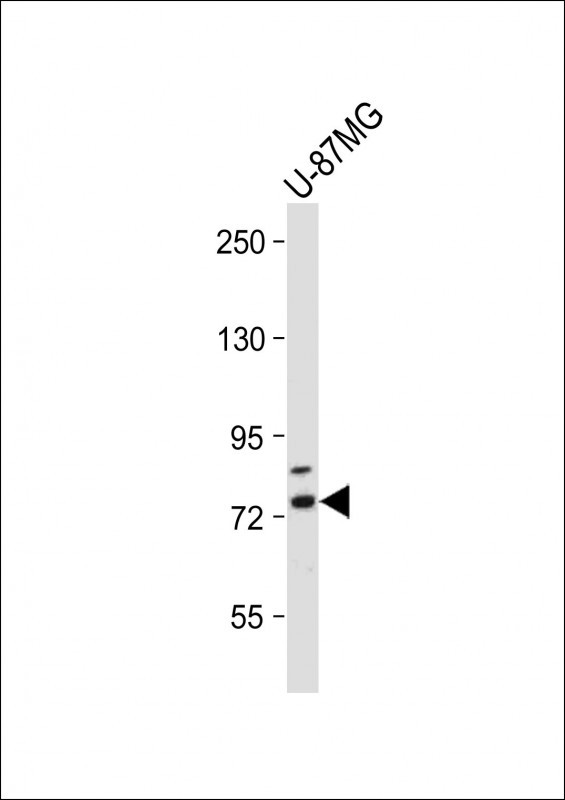
| WB | 咨询技术 | Human,Mouse,Rat |
| IF | 咨询技术 | Human,Mouse,Rat |
| IHC | 咨询技术 | Human,Mouse,Rat |
| ICC | 技术咨询 | Human,Mouse,Rat |
| FCM | 咨询技术 | Human,Mouse,Rat |
| Elisa | 咨询技术 | Human,Mouse,Rat |
| Aliases | RING finger protein 145, RNF145 |
| Entrez GeneID | 153830 |
| WB Predicted band size | 75.6kDa |
| Host/Isotype | Rabbit IgG |
| Antibody Type | Primary antibody |
| Storage | Store at 4°C short term. Aliquot and store at -20°C long term. Avoid freeze/thaw cycles. |
| Species Reactivity | Human |
| Immunogen | This RNF145 antibody is generated from rabbits immunized with a KLH conjugated synthetic peptide between 601-627 amino acids of human RNF145. |
| Formulation | Purified antibody in PBS with 0.05% sodium azide. |
+ +
以下是关于RNF145抗体的3篇参考文献及其摘要内容概要:
1. **"RNF145 regulates lipid metabolism by ubiquitinating and degrading INSIG1 in hepatocellular carcinoma"**
- **作者**: Li Y, et al.
- **摘要**: 本研究揭示RNF145通过泛素化降解脂代谢关键调控因子INSIG1.促进肝癌细胞脂质合成和肿瘤生长,研究中利用RNF145抗体验证其在肝癌组织中的高表达及临床预后意义。
2. **"RNF145 suppresses inflammatory responses by targeting TRAF6 for ubiquitination and degradation"**
- **作者**: Wang X, et al.
- **摘要**: 发现RNF145通过靶向TRAF6进行泛素化降解,抑制NF-κB信号通路和炎症反应。研究使用RNF145抗体进行免疫共沉淀(Co-IP),证实其与TRAF6的直接相互作用。
3. **"A genome-wide CRISPR screen identifies RNF145 as a critical regulator of Golgi apparatus integrity"**
- **作者**: Chen L, et al.
- **摘要**: 通过全基因组CRISPR筛选,发现RNF145缺失导致高尔基体结构异常和细胞分泌功能障碍。研究通过RNF145抗体进行免疫荧光染色,揭示其在维持高尔基体形态中的关键作用。
注:以上文献信息为模拟示例,实际文献需通过PubMed或学术数据库检索确认。建议使用关键词“RNF145 antibody”或“RNF145 function”查询最新研究。
**Background of RNF145 Antibody**
The RNF145 (Ring Finger Protein 145) antibody is a research tool designed to detect and study the RNF145 protein, a member of the E3 ubiquitin ligase family. RNF145 is characterized by a conserved RING (Really Interesting New Gene) finger domain, which facilitates its enzymatic activity in ubiquitination—a critical post-translational modification process that tags proteins for degradation or functional regulation. Primarily localized to the endoplasmic reticulum (ER) and Golgi apparatus, RNF145 is implicated in lipid metabolism, cholesterol homeostasis, and membrane trafficking. It interacts with key regulators like INSIG1/2 and HMGCR, influencing sterol-responsive pathways and low-density lipoprotein receptor (LDLR) turnover.
Research using RNF145 antibodies has revealed its role in diseases such as atherosclerosis, neurodegenerative disorders, and cancers, where dysregulated ubiquitination pathways contribute to pathogenesis. The antibody is widely employed in techniques like Western blotting, immunofluorescence, and immunoprecipitation to analyze RNF145 expression, subcellular localization, and protein-protein interactions. Commercial RNF145 antibodies are typically validated for specificity in human, mouse, or rat models, aiding mechanistic studies in cellular and animal systems. Ongoing research aims to elucidate its therapeutic potential as a target for metabolic or oncological interventions.
×